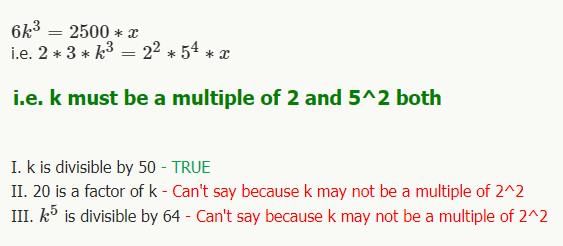Test: Prime Numbers- 2 - GMAT MCQ
20 Questions MCQ Test Quantitative for GMAT - Test: Prime Numbers- 2
A positive integer n has 3 prime factors. Is n odd?
(1) The total number of factors of n is odd.
(2) The prime factors of n when arranged in ascending order form an evenly spaced set.
(1) The total number of factors of n is odd.
(2) The prime factors of n when arranged in ascending order form an evenly spaced set.
The product of the largest two factors of a positive integer n is 16875. What is the difference between the largest positive integer that divides √n and the smallest odd factor greater than 1 of √n?
| 1 Crore+ students have signed up on EduRev. Have you? Download the App |
For a positive integer n, the function @n represents the product of all even numbers that lie between n and 2n, exclusive. For
example, @6 = 8*10. If k is a positive integer and the greates prime factor of @k is 17, which of the following cannot be the
value of k?
I. 9
II. 18
III. 32
example, @6 = 8*10. If k is a positive integer and the greates prime factor of @k is 17, which of the following cannot be the
value of k?
I. 9
II. 18
III. 32
For any integer P greater than 1, P! denotes the product of all the integers from 1 to P, inclusive. The value of 11! is closest to
which of the following powers of 10?
Does the positive integer M have greater than 4 factors?
(1) M/8 is an integer
(2) M/20 is an integer
p is a positive integer greater than 100. Is p divisible by 36?
(1) There are 8 positive integers, including 1 and p, which divide p.
(2) The highest positive integer less than or equal to 100 that divides p is 75.
Can the total number of integers that divide x be expressed in the form of 2k + 1, where k is a positive integer?
(1) √12x is an integer
(2) The product of √x and √y is an integer, where the total number of factors of y/3 is odd.
If m has the smallest prime number as its only prime factor, is ∛m an integer?
(1) m2 is divisible by 32
(2) √m is divisible by 4
For any integer P greater than 1, P! denotes the product of all the integers from 1 to P, inclusive. In how many ways can 9! be
expressed as a product of 2 positive integers?
What percentage of odd prime numbers lying between 1 and 30 divide 7,700 completely?
If the dimensions of a rectangle (in inches) is equal to a prime number that lies between 55 and 65, exclusive, which of the
following statements must be true?
I. There is only one other rectangle that has integral dimensions and the same area as the given rectangle
II. There is only one other rectangle that has integral dimensions and the same perimeter as the given rectangle
III. The area of the given rectangle is 3599 square inches.
If k is a positive integer and 6k3 is divisible by 2500, then which of the following statements must be true?
I. k is divisible by 50
II. 20 is a factor of k
III. k5 is divisible by 64
A class of students appeared in two different tests of quantitative ability both of which were scored out of 100. The scores of each
student in each test could be expressed as a product of two distinct prime numbers. If a student’s scores in the two tests did not have
any common prime factors, what is the maximum possible difference between his two scores?
A positive integer n has more than 1 distinct prime factor. Is the product of the prime factors of n less than n?
(1) The number of distinct factors of n, including n, is odd.
(2) n can be expressed as a multiple of 4.
For any integer P greater than 1, P! denotes the product of all the integers from 1 to P, inclusive. If 10! Is divisible by 10080h and h
is a perfect square, what is the greatest possible value of h?
How many odd positive integers divide the positive integer n completely?
(1) 16 is the highest power of 2 that divides n
(2) n has a total of 68 factors and 3 prime factors.
For any integer x greater than 1, x! denotes the product of all integers from 1 to x, inclusive. What is the hundred-thousands
digit of 25!?
What is the number of positive integers that divide k but do not divide k, where k is a positive integer?
(1) k2 has a total of 13 factors
(2) √k has a total of 4 factors
For any integer P greater than 1, P! denotes the product of all the integers from 1 to P, inclusive. What is the greatest integer m for
which 45m is a factor of 48!?
If z is the product of integers from 1 to 51, inclusive, what is the greatest value of k+ m, where k and m are integers greater than 1,
for which 45k * 32m is a factor of z?
|
115 videos|106 docs|113 tests
|
|
115 videos|106 docs|113 tests
|


















